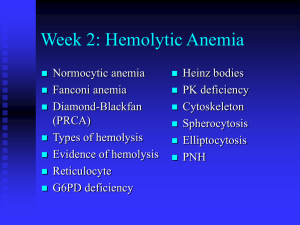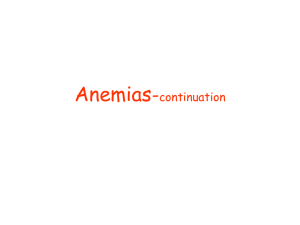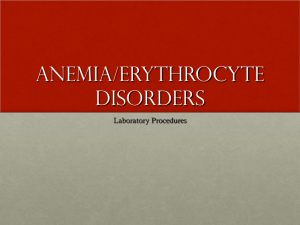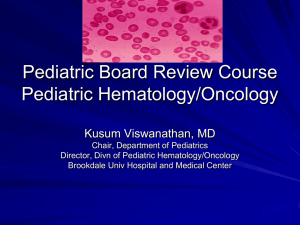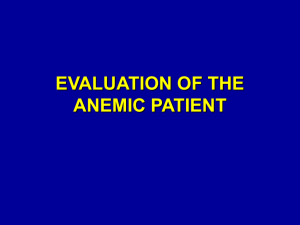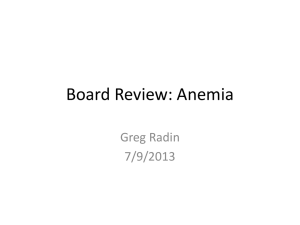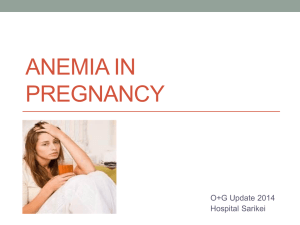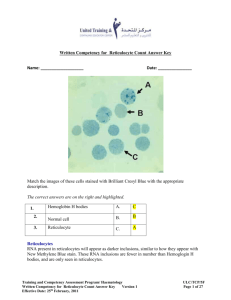Normal
advertisement
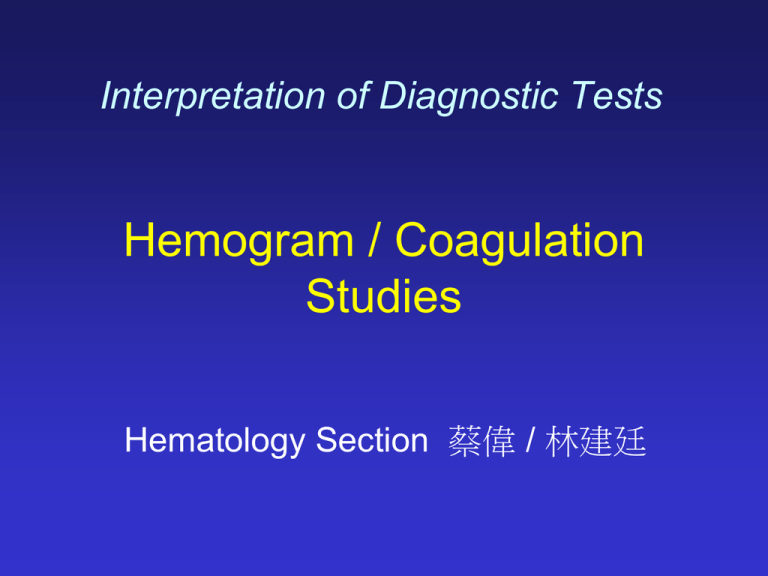
Interpretation of Diagnostic Tests Hemogram / Coagulation Studies Hematology Section 蔡偉 / 林建廷 How to Approach Anemia ? 1. Hb: make sure anemia 2. MCV: morphology approach 3. Reticulocyte: kinetic approach Definition of Anemia for Chinese Hemoglobin Adult male < 13.0 g/dL Adult femal < 11.0 g/dL Children < 11 g/dL Newborn < 15 g/dL 註:MCV = Hct / RBC, 貧血分類 大細胞貧血 Macrocytic anemia 正常細胞貧血 Normocytic anemia 小細胞貧血 Microcytic anemia fL: femtoliter 10-15 liter MCV (fl) 原因 100~160 • vit. B12 or folic acid deficiency • antimetabolic drugs • reticulocytosis • aplastic anemia • hypothyroidism 80~100 • myelodysplastic syndrome • leukemia • liver disease • uremia • endocrine disorders 55~80 • anemia of chronic disorders • iron deficiency • thalassemia 原則: • Disturb DNA synthesis → MCV ↑ • Disturb Hemoglobin synthesis → MCV ↓ MCV Distribution in Different Anemia Distribution of Reticulocyte vs Degree of Anemia PB BM Reticulocyte Mturation Time in P.B. Bone marrow 3.0 days 2.5 days 2.0 days 1.5 days Peripheral blood 1.0 day 1.5 days 2.0 days 2.5 days Hematocrit 45% 35% 25% 15% Reticulocyte Production Index an estimate of marrow production relative to normal Corrected Ret = Ret(%) × Hct 45 Corrected Ret RPI= Maturation index 舉例:某一貧血病患 Hct = 25%, reticulocyte count = 20% 計算 RPI= 20% X (25 / 45) ÷2.0 = 5.5 • RPI > 3 (2.5): hemolytic anemia • Normal: about 0.5~1.5 • RPI < 0.5: ineffective erythropoiesis or marrow hypofunction Stages in Development of Iron Deficiency I II III IV Loss of storage iron Loss of circulating iron Decrease of Hb production Decrease of tissuse iron serum ferritin transferrin saturation anemia & MCV atrophic tongue nail deformity pica behavior Transferrin saturation (%) = serum iron / total iron binding capacity 20~45% (30%) < 10% 10~20% > 90% Thalassemia Major or Intermediate Normal -thalassemia Fetus Adult 2γ2 (Hb F) 2β2 (Hb A) γ4 (Hb Bart’s) β4 (Hb H) high O2 affinity, unable to transport O2 β4 is unstable, intracellular → hydrops fetalis β-thalassemia 2γ2 (Hb F) (health fetus) precipitation (inclusion bodies) → hemolysis (major) 2γ2 (Hb F) ↑ 2δ2 (Hb A2) ↑ accumulation of -chain in RBC precursor → ineffective erythropoiesis (major) Anemia of Chronic Diseases Incidence: 15~20% of anemia Causes: neoplastic disorders chronic infectious disorders chronic inflammatory disorders Mechanisms: Multiple cytokines (TNF, IL-1, IL-6, βorγ-IFN, etc.) synergistically inhibit (partially mediated by excess hepcidin production from liver) erythropoiesis, EPO production & reticulendothelial iron release. Characteristics: 1. Hb level: ~7 to 10 g%; low reticulocyte count 2. normal or ↑ serum ferritin, and ↑ bone marrow iron storage 3. ↓serum iron and ↓TIBC transferrin saturation: 10~20% From: NEJM 352:1011, 2005 Microcytic anemia, MCV <80 Serum ferritin Normal or High Fe / TIBC Low I.D.A. Low Normal or High Thalassemia Anemia of chronic disorder Hb electrophoresis Normal Hb H, Hb Bart’s Hb H disease BCB test (+), or genetic study -thalassemia Hb A2 > 3.5% or Hb F > 2% Beta-thalassemia Mathematical Indices for Discriminating IDA from Thalassemia Cut-off value Sensitivity Specificity Youden’s index 5 million 84~96% 84~96% 74~82 220 75~100% 75~100% 63~80 65 70~97% 70~97% 67 MCV / RBC 13 62~89% 62~89% 48~65 Srivastava MCH / RBC index 3.8 60~91% 60~91% 37~50 1530 11~100% 11~100% 0~11 Indices Formula RBC RBC RDW index MCV × RDW / RBC Green & (MCV2 × RDW)/100 × King index RBC Mentzer index Shine & Lal index (MCV2) × (MCH/100) Pediatrics International 2002;44:612; Europ J Haematol 2007;78:524 Laboratory Signs of Hemolysis 1. unconjugated hyperbilirubinemia indirect bilirubin 2. relatively increased serum AST (GOT) AST>>ALT 3. serum LDH 4. corrected reticulocyte count reticulocyte production index > 3 5. serum haptoglobin Conditions influencing Haptoglobin Level Low haptoglobinemia 1. Hemolytic anemia (either intra- or extra-vascular) 2. Ineffective erythropoiesis, megaloblastic anemia 3. Hemorrhage into tissue 4. Severe liver disease and cirrhosis of liver 5. Congenital deficiency (about 2% in normal Causasians) 6. Newborn High haptoglobinemia 1. 2. 3. 4. 5. Chronic infection Trauma, tissue damage Surgery Malignancy Collagen diseases (RA, SLE) 6. Steroid or estrogen therapy, or oral pills 7. Pregnancy Intravascular vs Extravascular Hemolysis ↑serum bilirubin (T/I) Intravascular Extravascular +++ +++ Urine routine: ↑serum LDH +++ ++ Occult blood (++)~(++++) ↓serum haptoglobin but, Sediment RBC 0-5/HPF +++ ++ ↑urine urobilinogen ++ ++ Hemoglobinuria +++ - Hemosiderinuria +++ - Fragmented RBC ++ - - + Spherocytes Classification of Hemolytic Anemia Extravascular Hemolysis 1. Autoimmune HA 2. Hereditary spherocytosis 3. Pyruvate kinase deficiency Intravascular Hemolysis 1. ABO mismatched blood transfusion 2. Paroxysmal nocturnal hemoglobinuria 3. G6PD deficiency with oxidant stress 4. Microangiopathic HA (TTP, DIC, etc.) 5. Some autoimmune HA 6. Some drug- or infection-induced HA Laboratory Tests to Find the Cause of Hemolytic Anemia 1. Peripheral blood smear: polychromatic, poikilocytes, normoblast, Heinz bodies, spherocyte, elliptocytes, fragmented RBC 2. Coombs’ test (direct): Immune mechanism Cryoglobulin, cold hemagglutinin: mycoplasma infection, Antinuclear factor, complement C3, C4: SLE Immunofixation electrophoresis / immunoelectrophoresis 3. Signs of intravascular hemolysis: Hemoglobinuria 4. Sugar water test (screening): PNH acid-Ham test, anti-CD55, CD59, CD16, CD66 (confirmatory) 5. Osmotic fragility test: Spherocytosis 6. G6PD level 7. Hb electrophoresis, BCB (Hb H) test RBC morphology in Diagnosis of HA Morphology Cause Syndrome Spherocytes Loss of membrane Hereditary spherocytosis, Autoimmune warm HA, Burns, Chemical injury to RBC Target cells surface/volume Thalassemia, Liver disease Schistocytes (fragmented) Traumatic disruption of membrane Microangiopathic anemia (DIC, TTP), Prosthetic valve Heinz bodies Precipitated abnormal Hb Unstable Hb Causes of Macrocytic Anemia I. MCV > 115 Megaloblastic Anemia Vitamin B12 or Folic acid deficiency II. MCV 100 - 110 Reticulocytosis: Hemolysis or Blood loss Increased Membrane Surface Liver disease or Postsplenectomy Alcoholism (90% of patients) Hypothyroidism (50% of patients) Drugs: 6-MP, methotrexate, etc. Primary Hematological Disorders Aplastic anemia, Myelodysplastic syndrome, Leukemia, Myeloproliferative disease, Multiple myeloma, etc. Megaloblastic Anemia Mechanism: impaired DNA Synthesis Laboratory findings 1. PB: pancytopenia, reticulocyte↓, MCV↑, ovalocyte, hypersegmented neutrophils 2. Serum indirect bilirubin↑, LDH↑, haptoglobin↓ 3. BM:Megaloblastic hyperplasia Causes: 1. Vit. B12 deficiency: pernicious anemia, gastrectomy, vegetarian 2. Folate deficiency:poor dietary intake 3. (Drugs:methotrexate, other chemotherapy agents) Normal Megaloblastic Change Cause of Pancytopenia • P: PNH • A: Aplastic anemia • N: Neoplasm / Near neoplasm (including MDS) • C: Cirrhosis / Connective tissue disease • Y: Vit B12 / Folic acid • T: Toxin / Drug • O: Overwhelming sepsis (Hemophagocytic syndrome) / Others Aplastic Anemia P.B. RBC Aplastic anemia Severe aplastic anemia Hb< 10 Reticulocyte < 20K Very severe Reticuloaplastic cyte < 20K anemia Neutrophil Platelet < 1500 < 50K < 500 < 200 B.M. < 20K Cellularity < 25%, or 25-50% with < 30% residual hemopoietic cells < 20K Cellularity < 25%, or 25-50% with < 30% residual hemopoietic cells Absolute Count WBC ANC = WBC × (Seg% + Band%) Neutrophils 500 1000 1500 Neutropenia Lymphocytes Lymphocytopenia SLE ? 1500 4000 Lymphocytosis CLL ? Normal Leukemoid reaction CML Shift to left Acute Leukemia Hiatus Sign Leuko-erythroblastosis (myelophthisic sign) Definition: anemia with space-occupying lesions of the bone marrow that cause bone marrow suppression with immature cells of the erythrocytic and myeloid series in the circulation. P.B. smear findings: 1. Shifting to left (WBC) 2. Normoblasts Pathophysiology: Infiltration of marrow by ectopic cells disruption of marrow / blood barrier immature, differentiating marrow cells into P.B. Causes: 1. Metastatic cancers 2. Hematological maligancies 3. Myelofibrosis 4. Disseminated TB, or granulomatosis Bleeding Manifestations Clinical features Platelet disorders Coagulation disorders Petechia Characteristic Rare Superficial ecchymosis Small & multiple Large & solitary Deep dissecting hematoma Rare Characteristic Mucosal bleeding Common, Spontaneous Rare, except trauma or disease Hemarthrosis Onset of bleeding after trauma/surgery No Immediate Yes (common in hemophilia, rare in other factor deficiency) Delayed, or re-bleeding Screening Tests for Bleeding Patients 1. Platelet count thrombocytopenia 2. Template Bleeding time or PFA-100 vWD or platelet dysfunction 3. PT extrinsic or common pathway defect 4. aPTT intrinsic or common pathway defect 5. (TT and Fibrinogen) hypo- or dys-fibrinogenemia, inhibitors: FDP, heparin Platelet Counts (K/mm3 ) 400 Normal 150 CNS Surgery B.T. prolongation 100 80 Major Surgery Direct-vision procedures Hemorrhagic S / S 50 20 Muco-cutaneous bleeding Careful observation 10 Prophylactic transfusion CNS hemorrhage 5 400 K 300 K Von Willebrand disease, Normals Uremia 200 K 100 K Platelet count 50 K ITP 5 10 15 Ivy’s Bleeding Time 20 30 In Vitro Bleeding Time Platelet function analyzer (PFA-100) (Dade-Behring, Germany) a point-of-care assay Citrated whole blood, stable for 4 hr at room temp. Measure high shear-dependent platelet function Closure Time Limitation: Platelet >80K, Hct >30% Cartridge membrane coated with 1. Collagen-epinephrine (Col/EPI): primary screening 2. Collagen-ADP (Col/ADP): differentiation XII XI VII IX VIII X aPTT V PT II Fibrinogen Thrombin Time Fibrin Mixing Test for Differentiation between Factor Deficiency and Factor Inhibitor Normal pooled plasma Patient plasma 100% 0% PTT 80” 35” Patient plasma 0% 100% PTT 80” Mix and incubation Factor deficiency PTT 50% 35” Normal pooled plasma 35” Mix and incubation Factor Inhibitor PTT 10% 60” Laboratory Approach of Coagulation Inhibitors Step 1 (general screening): compare P N ( 1:1 ) vs. N (1) correctable: pure factor(s) deficiency (2) not correctable: inhibitors Step 2 (identification of inhibitors): immediate vs. 1~2 hr incubation (1) immediate prolongation: a) lupus anticoagulant b) factor IX inhibitor c) high titer of factor VIII inhibitor # further screen: P (dilute 50X or 100X ) N ( 1:1 ) (2) time-dependent prolongation: factor VIII inhibitor Step 3 (screening for low-titer inhibitors): compare P N( 4:1 ) vs. N , incubation for 2 hr Positive Bleeding History Screening Tests CBC, Bleeding Time (PFA-100), PT, aPTT Defects of Primary Hemostasis vWD vWF:Ag vWF:RCo FVIII:C RIPA vWF multimers Platelet Disorders Coagulation Factor Deficiency FVIII FIX FXI aPTT-based assays FVII FX FV PT-based assays Platelet aggregation test Platelet number & morphology
